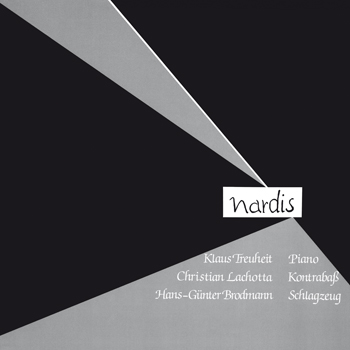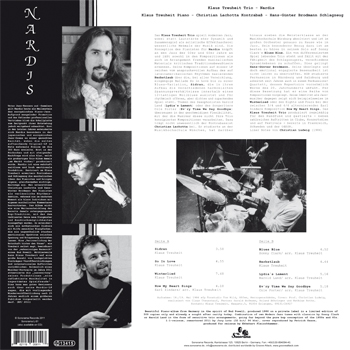CD & Vinyl-LP: Sonorama C-61/ L-61
KLAUS TREUHEIT TRIO - NARDIS


S 01
Track
Composer
Time
01
Sidran
Klaus Treuheit
3:58
02
So In Love
Klaus Treuheit
4:55
03
Winterlied
Klaus Treuheit
7:48
04
How My Heart Sings
Earl Zindars/ arr. Treuheit
4:18
S 02
Track
Composer
Time
01
Blues Blue
Sonny Clark/ arr. Treuheit
4:52
02
Herbstlaub
Klaus Treuheit
4:44
03
Lydia`s Lament
Harold Land/ arr. Treuheit
5:16
04
Ev`ry Time We Say Goodbye
Cole Porter/ arr. Treuheit
5:18
Klaus Treuheit - Piano, Christian Lachotta - Double Bass, Hans-Günter Brodmann - Drums
Recording: May 18/19 1986 sfp Tonstudio Tom Wild, Höfen, Herzogenschänke,
Cover: Prof. Christian Ludwig, realized by Claus Theuerkauf,
Photos: Harald Hofmann, Roland Böhringer and Mathias Rothe.
Remastered for reissue in 2011 by Jury Lutz at 32 bit/ 96 khz
Release Date: 23.09.2011
"The authenticity derives from the moment" (Klaus Treuheit)
Recording: May 18/19 1986 sfp Tonstudio Tom Wild, Höfen, Herzogenschänke,
Cover: Prof. Christian Ludwig, realized by Claus Theuerkauf,
Photos: Harald Hofmann, Roland Böhringer and Mathias Rothe.
Remastered for reissue in 2011 by Jury Lutz at 32 bit/ 96 khz
Release Date: 23.09.2011
"The authenticity derives from the moment" (Klaus Treuheit)
Among jazz connaisseurs and collectors, Nardis has become a milestone in European piano jazz. Due to lack of promotion and lack of a professional sales department, the record remained largely unnoticed at the time of production. But in recent years Nardis developed into a desired rarity especially in Japan and in various European countries, where the seldom appearing original LP started to fetch prices around 300 € on the internet. Only the retrospection and increasing demand make it clear now, what a great trio album had been produced outside the market.
Nardis is a truly timeless and highly emotional production. Centered around Klaus Treuheit, double bass and drums are the extensions of the pianist`s musical ideas, making their own equally important contributions. Sometimes Christian Lachotta and Hans-Günter Brodmann just back up the pianist as a reliable rhythm section, while in the next moment they become individuals with their own musical comments. That`s why the album stands out as a further development of the already then submerged bop tradition, adding new sound patterns and forms of expression to the faded genre. It develops an aesthetic discourse by the help of sensitive tone-colours in a strong emotional range between tension and relaxation. An "internalization of the message behind the notes" as Treuheit says himself, influenced by the "incredible harmonies" of Bud Powell.
Meanwhile, the man looks back to a large number of highly acclaimed record releases and succesful performances in many countries. During a musician portrait in 2011, the German magazine “jazzzeitung” attested his productions, "a thoughtful musicality in an impetuous joy of playing." With good conscience this can also be said about his Nardis LP, that is reissued here after 25 years to finally reach a wider audience (EF/ 2011).
Original liner notes by Christian Ludwig (1986):
The Klaus Treuheit Trio plays modern jazz, where instead of volume, dynamics and interaction rather than solo showmanship are essential to the music. The conception of the pianist for Nardis is linked to the jazz of the '50s and '60s and reveals a critical sense of tradition in both the compositions and arrangements of the extraneous musical material.
His compositions on this LP range from the sophisticated structure of Herbstlaub based on Latin rhythms to the - despite of all entanglement - catchy ballad So in Love, and to a blues variation, Sidran, that reflects the various harmonic tensions of its construction within a 12-bar minor blues, and stands for a rhythmic open, but tight and decisive style of playing. Themes of saxophonist Harold Land (Lydia's Lament), or the songwriter Cole Porter (Ev `ry Time We Say Goodbye), that have not been conceived for the trio, are handled here with a sleek flexibility.
Bassist Christian Lachotta bears more than a small part of it. He studied at the Musikhochschule in Munich, has just completed the master class at the Musikhochschule Wuerzburg and feels at home in the full orchestra as well as in jazz. His specific reference to jazz is heard best in his solo on Sonny Clark's Blues Blue. A trio that lives from its differentiated style of playing, stands and falls with the ability of the drummer to create different dynamic levels. Hans-Günter Brodmann succeeds in it. His well-considered and yet emotionally committed broom work is not easy to surpass. HGB studied percussion in Nuremberg and Salzburg and has worked in a percussion quartet for years, with a repertoire including mostly works from the 20th Century. For this formation he has presented a series of compositions. His identity as a jazz musician, however, shows itself for example in Winterlied or the Eights and Fours in the Earl Zindar composition How My Heart Sings, that alternates between 3/4 and 4/4.
The Klaus Treuheit Trio produces regularly for the radio and already made guest appearances - in addition to numerous appearances at clubs, concert halls and festivals - in France, Sweden and the USSR.
Klaus Treuheit – some stations:
Production of his compositions for radio since the late 70's (including BR, RAI). Numerous recordings both as soloist and with his ensembles. Has written stage and film music, e.g. for Aki Kaurismäki. Performed a.o. in Brazil, Italy, Spain, France and USA. Guest performances or studio recordings a.o. in New York (Knitting Factory), Paris (Competition Martial Solal), Venice, Naples, Krakow, Barcelona, Salzburg, Berlin, Hamburg, Brasilia, Sao Paulo and Tbilisi. Master class with Herbie Hancock and Tony Williams at the Mozarteum in Salzburg 1987. Lecturer of Sociology at the University of Erlangen from 1988 to 1994. Master Class with Barry Harris' Jazz Workshop New York 1992. Project with members of the Living Theatre ("This House Is Mine", 1995). Artistic Director of the "Spielraum"-series of 2003-2008.
Produced for reissue by Ekkehart Fleischhammer, album originally released in 1986 on a private label, original recordings remastered by Jury Lutz (32 bit/ 96khz), cover art by Prof. Christian Ludwig, realized by Claus Theuerkauf, reproduced by Patrick Haase, photos by Harald Hofmann, Roland Böhringer und Mathias Rothe, original liner notes by Christian Ludwig.
Nardis is a truly timeless and highly emotional production. Centered around Klaus Treuheit, double bass and drums are the extensions of the pianist`s musical ideas, making their own equally important contributions. Sometimes Christian Lachotta and Hans-Günter Brodmann just back up the pianist as a reliable rhythm section, while in the next moment they become individuals with their own musical comments. That`s why the album stands out as a further development of the already then submerged bop tradition, adding new sound patterns and forms of expression to the faded genre. It develops an aesthetic discourse by the help of sensitive tone-colours in a strong emotional range between tension and relaxation. An "internalization of the message behind the notes" as Treuheit says himself, influenced by the "incredible harmonies" of Bud Powell.
Meanwhile, the man looks back to a large number of highly acclaimed record releases and succesful performances in many countries. During a musician portrait in 2011, the German magazine “jazzzeitung” attested his productions, "a thoughtful musicality in an impetuous joy of playing." With good conscience this can also be said about his Nardis LP, that is reissued here after 25 years to finally reach a wider audience (EF/ 2011).
Original liner notes by Christian Ludwig (1986):
The Klaus Treuheit Trio plays modern jazz, where instead of volume, dynamics and interaction rather than solo showmanship are essential to the music. The conception of the pianist for Nardis is linked to the jazz of the '50s and '60s and reveals a critical sense of tradition in both the compositions and arrangements of the extraneous musical material.
His compositions on this LP range from the sophisticated structure of Herbstlaub based on Latin rhythms to the - despite of all entanglement - catchy ballad So in Love, and to a blues variation, Sidran, that reflects the various harmonic tensions of its construction within a 12-bar minor blues, and stands for a rhythmic open, but tight and decisive style of playing. Themes of saxophonist Harold Land (Lydia's Lament), or the songwriter Cole Porter (Ev `ry Time We Say Goodbye), that have not been conceived for the trio, are handled here with a sleek flexibility.
Bassist Christian Lachotta bears more than a small part of it. He studied at the Musikhochschule in Munich, has just completed the master class at the Musikhochschule Wuerzburg and feels at home in the full orchestra as well as in jazz. His specific reference to jazz is heard best in his solo on Sonny Clark's Blues Blue. A trio that lives from its differentiated style of playing, stands and falls with the ability of the drummer to create different dynamic levels. Hans-Günter Brodmann succeeds in it. His well-considered and yet emotionally committed broom work is not easy to surpass. HGB studied percussion in Nuremberg and Salzburg and has worked in a percussion quartet for years, with a repertoire including mostly works from the 20th Century. For this formation he has presented a series of compositions. His identity as a jazz musician, however, shows itself for example in Winterlied or the Eights and Fours in the Earl Zindar composition How My Heart Sings, that alternates between 3/4 and 4/4.
The Klaus Treuheit Trio produces regularly for the radio and already made guest appearances - in addition to numerous appearances at clubs, concert halls and festivals - in France, Sweden and the USSR.
Klaus Treuheit – some stations:
Production of his compositions for radio since the late 70's (including BR, RAI). Numerous recordings both as soloist and with his ensembles. Has written stage and film music, e.g. for Aki Kaurismäki. Performed a.o. in Brazil, Italy, Spain, France and USA. Guest performances or studio recordings a.o. in New York (Knitting Factory), Paris (Competition Martial Solal), Venice, Naples, Krakow, Barcelona, Salzburg, Berlin, Hamburg, Brasilia, Sao Paulo and Tbilisi. Master class with Herbie Hancock and Tony Williams at the Mozarteum in Salzburg 1987. Lecturer of Sociology at the University of Erlangen from 1988 to 1994. Master Class with Barry Harris' Jazz Workshop New York 1992. Project with members of the Living Theatre ("This House Is Mine", 1995). Artistic Director of the "Spielraum"-series of 2003-2008.
Produced for reissue by Ekkehart Fleischhammer, album originally released in 1986 on a private label, original recordings remastered by Jury Lutz (32 bit/ 96khz), cover art by Prof. Christian Ludwig, realized by Claus Theuerkauf, reproduced by Patrick Haase, photos by Harald Hofmann, Roland Böhringer und Mathias Rothe, original liner notes by Christian Ludwig.
